Plants with blue flowers - these are the favorites of many gardeners.
And it’s not surprising, because the blue color fascinates, amazes with its depth, calms and gives rest to tired eyes.
Plants with blue bells, “stars”, “daisies” remind of the sea and sky blue, improve mood and give peace.
Let's take a closer look at these wonders of nature.
Indoor plants with blue flowers
 Brovallia is beautiful Blue Bell, in Latin called Browallia speciosa major Blue Bells.
Brovallia is beautiful Blue Bell, in Latin called Browallia speciosa major Blue Bells.
Browallia is a plant in the form of a lush bush no more than 30 cm high, strewn with a huge number of bright blue flowers. The dark green foliage and blue star flowers create a very striking contrast.
This unpretentious plant notable for the fact that with proper maintenance it can bloom for up to 18 months in a row. Browallia blooms only once, after which the plant is renewed and it blooms again.
 or in Latin Campanula isophylla Moretti Mayi.
or in Latin Campanula isophylla Moretti Mayi.
Campanula, popularly nicknamed “the bride and groom,” blooms with wonderful bells framed by heart-shaped leaves.
This hybrid is a compact bush covered with a scattering of blue flowers and is called the “groom,” while the variation with white flowers is called the “bride.” This is a very unpretentious plant that can bloom almost all year round. The lifespan of Campanula is not long - after 1 or 2 years it is necessary to take cuttings and renew the plant.
 empress blue ink, in Latin called Gloxinia hybrida Impress Blue Ink
empress blue ink, in Latin called Gloxinia hybrida Impress Blue Ink
Gloxinia is everyone favorite plant, blooming with huge bells. There are many blue and blue colors of gloxinia. Hybrid " Blue ink"is impressive with the juicy blue color of the gramophones, strewn with openwork specks. This spectacular plant does not have high maintenance requirements and blooms very profusely.
 Crocus botanical Blue pearl, in Latin called Crocus biflorus Blue Pearl.
Crocus botanical Blue pearl, in Latin called Crocus biflorus Blue Pearl.
This bulbous plant with unusually delicate and beautiful flowers is successfully grown in room conditions. It is difficult to imagine a plant that could compare with the crocus in its richness of colors, including the most delicate “Blue Pearl,” and its ability to create a spring mood. Crocuses are not at all picky about care; they can be placed as a whole “family” in one small pot and bloom when other plants have not yet woken up from hibernation.
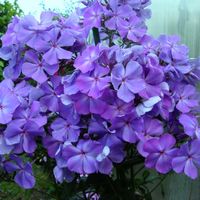 Phlox paniculata Blue Paradise or in Latin Phlox paniculata Blue Paradise.
Phlox paniculata Blue Paradise or in Latin Phlox paniculata Blue Paradise.
Phlox, beloved by many gardeners, represents a rich range of flower shades. Among them, one can distinguish a variety with anthocyanin flowers, the color of which looks blue during the day, and in cloudy times and in the evening - radical blue. Phlox is famous for its abundant and long-lasting flowering, as well as its ease of care.
 Syrian hibiscus Blue satin, in Latin called Hibiscus syriacus Blue Satin.
Syrian hibiscus Blue satin, in Latin called Hibiscus syriacus Blue Satin.
It is impossible not to fall in love with hibiscus, whose luxurious flowering and ease of care have made it very popular among gardeners. With blue petals, a blue center and white stamens, this is truly a plant of paradise.
Well-groomed hibiscus in the form of a compact bush or standard tree decorates the interior and pleases the eye. Large flowers hibiscus flowers bloom one after another and continue to bloom all year round.
 Achimenes Aquamarine or in Latin Achimenes Aquamarine.
Achimenes Aquamarine or in Latin Achimenes Aquamarine.
This profusely blooming achimenes will delight any gardener who dreams of home flower with blue flowers. Achimenes is not at all whimsical, rests in winter without leaves and requires only minimal care. The leaves of this species are different burgundy shade. Achimenes can be grown as hanging plant.
 Saintpaulia Chimera or Usambara violet, in Latin called Saintpaulia Chimera.
Saintpaulia Chimera or Usambara violet, in Latin called Saintpaulia Chimera.
Saintpaulia is an unpretentious plant with dark green leaves and many variations of flower colors. Particularly interesting is the “Chimera” variation, which combines soft blue and blue colors. The plant is different abundant flowering and great decorativeness.
 Primula vulgare dark blue, which in Latin sounds like Primula vulgaris dark blue.
Primula vulgare dark blue, which in Latin sounds like Primula vulgaris dark blue.
This is a plant whose tall flower stalks create lush bouquets of flowers above a rosette of leaves. The dark blue variation has additional charm due to the contrast with the bright yellow center of the flowers.
Primrose is the very first spring Flower, whose velvety petals and luxurious foliage can lift anyone's spirits. Primrose’s unpretentiousness and early flowering, when all other flowers are still “sleeping,” make it a favorite of many gardeners.
 Clitoria trifoliate or in Latin Clitoria ternatea.
Clitoria trifoliate or in Latin Clitoria ternatea.
This plant is interesting for its unusually rich flowers. of blue color. In the East, the famous blue tea, which is very healthy and tasty, is even brewed from the petals of the clitoris. In addition, a dye is extracted from clitoria flowers. IN indoor culture the plant requires some experience from the grower and blooms in spring and summer.
 Streptocarpus rex, in Latin called Streptocarpus rexii.
Streptocarpus rex, in Latin called Streptocarpus rexii.
Streptocarpus is very popular among gardeners. Extraordinary beautiful flowers Streptocarpus, its delicate foliage and moderately capricious character provide it with undiminished attention. There are many interesting colors of this plant. Streptocarpus Rex is distinguished by the delicate and at the same time rich blue color of the flower and dark blue veins emanating from the center.
 Cineraria hybrid or in Latin Cineraria Senecio hybridus Asteraceae.
Cineraria hybrid or in Latin Cineraria Senecio hybridus Asteraceae.
Cineraria blooming in spring is wonderful plant for those who want to see a bouquet of cute flowers on their windowsill. Among the many variations of cineraria, one can distinguish the popular dark blue color with a white center. Caring for cineraria is not at all difficult.
Read this article for more details.
If you decide to get a cissus, take useful information to select the best species for cultivation.
Caring for nephrolepis at home will be simple if you follow these tips.
As you can see, a lot of plants can please the eye with shades of azure or deep blue. Some of them are more whimsical, some less, but they are all equally beautiful.
Which plant to choose depends on what is closest to you. Give your new “green friend” a little attention and care - and he will not be slow to please you with luxurious blue flowers.
When creating compositions on their window sills and in mini-gardens, flower growers select plants with flowers a certain color. As a rule, to give the room a romantic, gentle atmosphere, indoor flowers are planted with blue flowers. There are a great variety of such plants: for example, lisianthus, streptocarpus, Uzambara violet, sollia, cucumber and many others. They all have soft blue flowers and pair beautifully with cream or shaded plants.
In this article we will tell you which blue flowers take root best at home and give recommendations for caring for them. You can also see photos of blue flowers below and read their description.
Blue lisianthus flowers
Lisianthus(LISIANTHUS) has poppy blue flowers arranged in groups. There are double and non-double varieties in purple, mauve and white colors. These are straight bushy perennials, but in the nursery they are treated with retardant - a growth retardant for indoor plants. Lisianthus are difficult to keep in a room for more than one season.
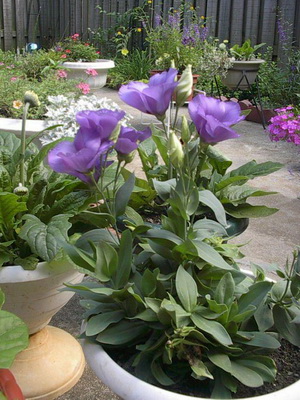

There is only one type on sale - with the name on the label or Russell's lisianthus(Lisianthus russelianus), or eustoma grandiflora(Eustoma grandiflorum). Compact varieties 30-45 cm tall are offered, rather than tall varieties.
Temperature: Moderate. Keep in winter period in a cool place.
Light: Brightly lit areas - some amount of sunlight is beneficial.
Watering: Water thoroughly, then allow the soil to dry out moderately.
Air humidity: Spray foliage frequently.
Care after flowering: Plants are usually not preserved. Reproduction: By sowing seeds in spring or dividing plants in autumn.
Which blue flowers are most popular: streptocarpus


Streptocarpus(STREPTOCARPUS) has many hybrids, but the old variety Constant Nymph is still the most popular streptocarpus. A blue flower appears above a rosette of large leaves with enviable frequency - this plant blooms throughout the summer. He needs shallow pot, moist air, bright light and protection from drafts and cold air in winter.
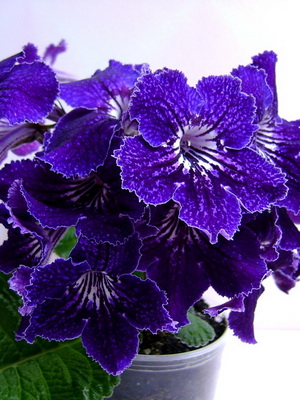
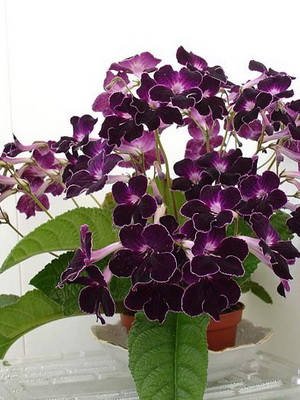
The flowers of Streptocarpus Constant Nymph are lilac with purple veins. In other varieties they are white, blue, purple, pink or red.
Temperature: Moderate - minimum 13°C in winter.
Light: Brightly lit places, protected from direct sunlight in summer.
Watering: Water deeply, then allow the surface of the soil to dry out between waterings. Water sparingly in winter.
Air humidity: Spray from time to time. Do not wet the foliage.
Transfer: Replant annually in the spring.
Reproduction: Dividing plants during transplantation. Seeds can be sown in spring.
Blue Usambara violet flower
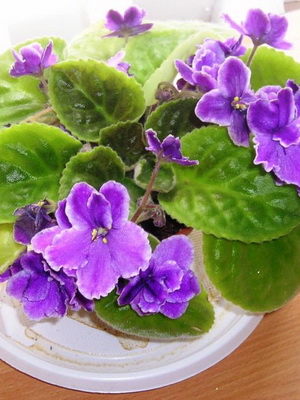
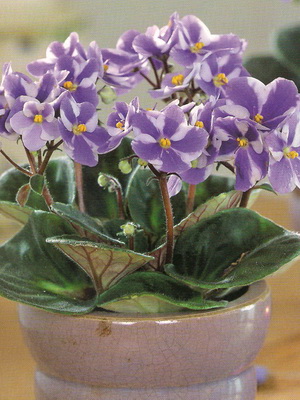
Usambara violet or saintpaulia(SAINTPAULIA) blooms very profusely. The main advantage of this indoor flower with blue flowers is its compact size and ability to produce several waves of flowering each year. Plants need stable heat proper watering, good lighting, high humidity air and regular feeding. Remove spent flowers and leaves immediately.


There are thousands of varieties Saintpaulia hybrid(Saintpaulia hybrida) ranging in size from 8 cm to 40 cm or more. The flowers are simple, double, corrugated, two-colored and star-shaped.
Temperature: Moderate - minimum 16°C in winter.
Light: Bright light: east or south oriented window in winter - west oriented window in summer. Shade from the sun.
Watering: Keep the soil fresh at all times wet using lukewarm water.
Air humidity: Humid air is necessary.
Transfer:
Reproduction: Leaf cuttings in spring.
Indoor flower with blue flowers


Clusters of sky blue flowers lead(PLUMBAGO) appear in summer and autumn. The vigorous growing vine can be grown on a sunny windowsill as a single plant or formed into a frame around a window. These houseplants blue flowers should be kept in a cool place throughout the winter and early spring.

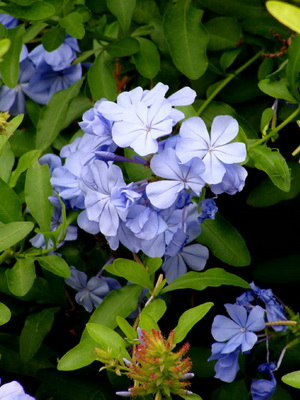
Sulcata auricularis(Plumbago auriculata) grown as an ampel plant or as a vine on a support. Its stems can reach 1 m; They are pruned in the spring. There is a variety with white flowers (alba).
Temperature:
Light: Bright light with some direct sunlight.
Watering: Keep the substrate moist at all times. Water sparingly in winter.
Air humidity:
Transfer: Replant if necessary in spring.
Reproduction: Stem cuttings in the fall. Sowing seeds in spring.
Blue sollia flower


Are giants but a humble plant sollia(SOLLYA) grows only up to 1 m. In summer, bent, bell-shaped flowers of a soft blue color appear, and they are replaced by purple fruits. This blue flowered plant is one that is not easy to find, but is worth looking for.


Sollia varifolia(Sollya heterophylla) Can be used to cover tall decorative leafy plants.
Temperature: Cool or moderate temperature; minimum 7°C in winter.
Light: Well lit or slightly shady place.
Watering: Keep the soil moist at all times during the growing season, but water more sparingly during the winter.
Air humidity: Spray the foliage from time to time.
Transfer: Replant if necessary in spring.
Reproduction: Stem cuttings in spring.




